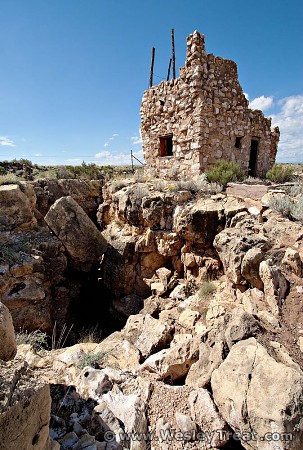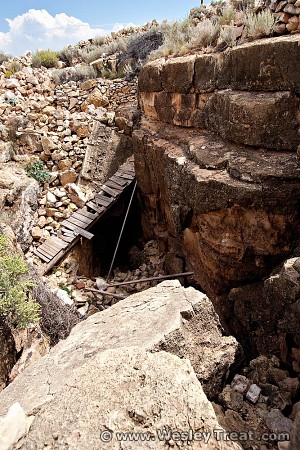The site known as Two Guns, where Interstate 40 now crosses Canyon Diablo, was long avoided by the region's Native American tribes. It was believed to be an area fraught with ill fortune, cursed by the dead. White settlers who inquired about the site or attempted to build there were warned to steer clear. Naturally, outsiders didn't always listen, and those who ignored the warnings eventually learned of the spirits that stirred in the canyon's shadows.
The ghosts are said to be those of a band of Apaches who were executed in 1878 after raiding Navajo encampments. The Apaches had crossed north over the Little Colorado River and charged a neighboring Navajo tribe in a surprise attack. Except for three girls taken prisoner, the invaders swiftly murdered every man, woman and child in camp, then ransacked the victims' homes. At the same time, a second band of Apaches looted another camp a few miles away, murdering 30 more Navajos before both groups returned south.
Receiving word of the attacks, Navajo leaders immediately organized 25 men and raced off in pursuit of the invaders. The posse tracked them across the river, rushed to intercept them, then set up along logical routes hoping to ambush the party. The Apaches, however, never came through. It was as if they had disappeared.
The Navajos combed the region, but could find no trace of the assassins. It looked as though the Apaches had outsmarted them. When two Navajo scouts thought to check a short arm of Canyon Diablo, however, they were startled by a stream of hot air emanating from a crack in the earth, followed by the sound of voices. The Apaches were underground! This shallow side canyon, which became extremely narrow, passed beneath a short natural bridge that concealed the entrance to a cave. It was practically undetectable. Here, the Apaches had holed up, horses and all.
Having discovered their hideout, the Navajos descended on the cave as night began to fall. They crawled to the edge of the canyon, aimed their guns at the passageway and waited. With only one way out, the Apaches were trapped.
Still oblivious to their discovery, two Apache men then unwittingly walked out into the canyon. They instantly fell dead from Navajo gunfire. When the remaining Apaches realized what happened, they tried to fight back, but the cave opening was too narrow to negotiate a shot. Moreover, the only way they could advance into the open canyon would be single file, completely vulnerable to the Navajos' bullets. They had nowhere to go and no way to defend themselves.
Meanwhile, intent on seeking justice for their slain brethren, several of the Navajo warriors began to gather brush and kindling. This they set ablaze and dropped down in front of the cavern's entryway. For fear of suffocation, some Apaches tried to push the burning mass away, but were killed in the process. From inside, others threw water on the fire and attempted to block the entrance with stones, but their efforts had little effect.
One Apache tried to negotiate with his captors, but when the Navajo leaders demanded he release the three girls they had kidnapped, the man hesitated. His stalling confirmed what the Navajos feared: the girls had already been executed.
Enraged, the Navajos threw on more fuel. They filled the entrance with all the sagebrush and driftwood they could gather. Smoke rose from the surrounding cracks. Screams echoed from inside, mixed with the sounds of panicked horses. Toward the end, the men above could hear the last survivors choking out their death chants.
Once the embers faded and the rocks cooled, a few Navajos entered the cave to recover their stolen possessions. There, they witnessed the horrific aftermath. Just inside, a wall of charred animal meat obstructed the entrance. Having slain their horses, the Apaches tried to extinguish the flames with the blood, then butchered the carcasses and stuffed them into the entryway in an effort to block the smoke. When this last attempt failed, all 42 Apaches succumbed to the fire. The cave, intended as a refuge, had become their final resting place.
In the decades that followed, pioneers who ignored the Indians' warnings concerning the area relayed recurring reports of ghostly activity. Their settlements were plagued by groans and disembodied footsteps outside their cabins.
In addition, the town of Two Guns, which was built practically on top of the cave, suffered from what locals believed to be a curse. Buildings were ravaged by multiple fires and the landowner murdered. Additionally, the section of Route 66 that passed nearby was responsible for a disproportionate number of accidents.
One entrepreneur went so far as to turn the Apaches' tomb into a tourist attraction and use the skeletal remains he found inside as props; he was later mauled twice by wild cats and eventually run out of town. No business venture has survived on the site since.
The charred walls of the Apache Death Cave have since faded, its remaining bones removed and its natural bridge collapsed by an earthquake. But those who have dared disturb it would surely tell you it has never been completely vacated.





